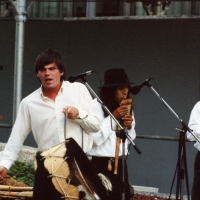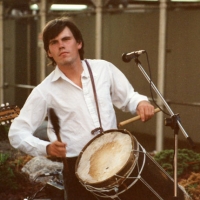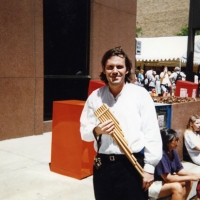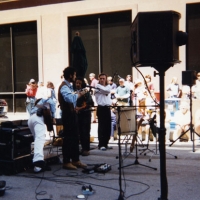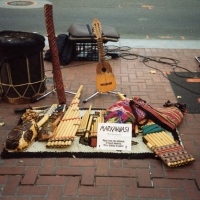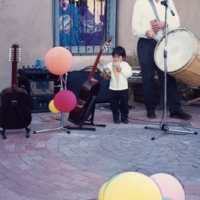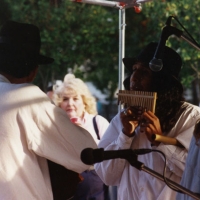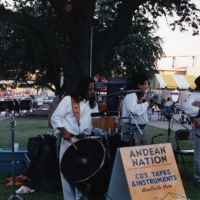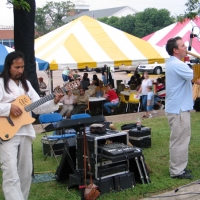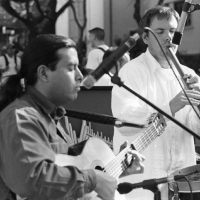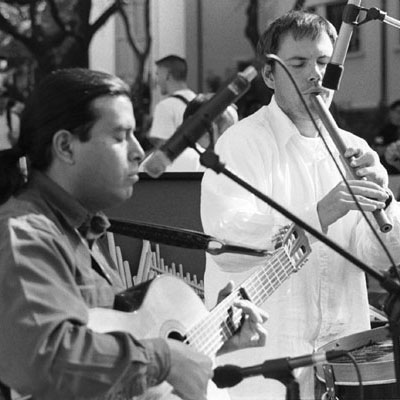 The Beginning
The Beginning
Andrew Taher was the child of a foreign-service officer who spent most of his childhood overseas. Brazil, France, Germany, Chile and Switzerland were tours that took the family abroad throughout the seventies and eighties. It was during their tour of Chile where Andrew was first introduced to Andean culture and music. Following his high school graduation in December of 1984, at the age of 17, Andrew spent several months backpacking/hitchhiking throughout Chile, Argentina, Bolivia and Peru.
“In hindsight, the adventure of traveling through those countries impacted me profoundly. In Bolivia we would travel in the back of trucks with local people and stumble upon small towns and villages. Being fluent in Spanish meant that we were able to quickly adapt to any circumstance. We made it to Oruro, Bolivia, in time for carnival in mid February. Several weeks later we were hiking the Inca trail to Macchu Picchu via the Salkantay trail, through mountain passes that reached 5000 meters. The experience was indelible.”
While in college, he began the arduous process of learning to play Andean folk instruments.
“I revisited Chile in 1987 and spent several months living with friends in the Andean foothills. I was introduced to the music of Chilean legends Inti-illimani and Quilapayun. I took a bunch of cassettes back to college with me and fell in love with the sound of the kena. I had to learn how to play.” “Ever since I was a child I had musical aptitude, my primary influences were the popular rock groups of the seventies: Deep Purple, Led Zeppelin, and Aerosmith etc. In Chile I sang lead vocals with a rock band that was fairly successful, we would gig around Santiago and Viña Del Mar. I had no formal musical training, it was all by ear.”
“I had several friends who were kind enough to give me instruments. My first kena was sent from Chile, along with an instruction manual by Bolivian master Ernesto Cavour. It took me days to discover that the kena had several small holes in it, which made it difficult to play (I filled the holes with wax). Several Bolivian friends from college brought me more treasures: a higher quality kena, a siku, or zampoña, along with an instruction manual for the Siku by the same author. I was entranced. By this time I was listening to the Bolivian group Savia Andina on cassettes given to me by a Bolivian student. While my peers were off partying, I was home fervently trying to master songs on my instruments. I even borrowed a guitar and started learning folk songs from different recordings. I think my initial interest in Andean music was motivated by a deep sense of nostalgia and longing. Leaving Chile was a difficult experience for me. I became highly interested in the Chilean new song movement that was embodied by artists like Violeta Parra and Victor Jara. And because I loved to sing, it was a perfect match. Eventually I was able to find people with similar interests: my professors! We would get together and play music on cold winter nights in upstate New York, my teachers on their guitars and I on my flutes.”
Markahuasi
Markahuasi was one of the first Andean Groups to hit the Bay Area in the late 1980s. It was the vehicle that took Andrew into a new and unexpected career path.
“In 1991, I worked as a bilingual tutor in a junior high school in Boulder, Colorado. As the end of the year approached, I had decided to return to the east coast. During what was supposed to be my last month in Colorado, I encountered an Andean group called Markahuasi on the Pearl Street Mall. It included four Peruvians and one Colombian who were based out of San Francisco. I was befriended by the group and soon thereafter was invited to join the band. At the end of the school year I grabbed my few possessions and moved to Denver to begin my odyssey as an itinerant street performer. In those days it was truly a street performance, setting up on downtown street corners in cities across the US. Initially we sold cassettes as CDs were just being introduced to the public. We spent that summer and fall traveling across the country to Denver, Chicago, Boston, Santa Fe, Albuquerque, and eventually back to San Francisco for the winter. It was truly serendipitous that I became a member of the group. It offered the learning opportunity for which I had yearned for so many years. Both flute players of the group were consummate professionals who I watched closely. Carlos Lara was an imposing figure of indigenous ancestry who initially greeted me with some suspicion. Eventually we would become close friends and I credit him with having mentored me on the Andean flutes. Carlos Hilario was a technically gifted kena player who was able to play anything. He was taciturn and quiet, often lost in whatever instrument he was playing. Sadly, Carlos Hilario succumbed to cancer in February of 2012. Carlos Lara was deported in 2005 after many years of appealing to the INS for political asylum. Markahuasi splintered in 1993 when two members (brothers José and Carlos Hilario) decided to go their own way. I remained in San Francisco with Markahuasi until the end of 1994 when the group dissolved and I formed my own group, Andean Nation.”
Andean Nation
Following the dissolution of Markahuasi, many new and exciting opportunities presented themselves to Andrew.
“Andean Nation originally began as a side business importing instruments from Bolivia in 1994. I went to Bolivia in 1993 and purchased a number of instruments to sell. I also brought back bamboo and reed to make my own instruments and to share with Markahuasi members. It was during this trip that I first met the Alandres family, who lived in Cochabamba, Bolivia. We met in La Paz at the Feria De Alasitas in January of 1993, a fair that is held every year for artisans from all parts of Bolivia. We share an ongoing working relationship and friendship to this date. In the Bay Area, I sold instruments wholesale to retail stores and to other Andean groups. In 1996 I published my instruction manuals for the Kena and Siku.
I revisited Bolivia in 1994 and in 2002. It was during my last visit that I was introduced to Bolivian legend Fernando Torrico. We collaborated on a CD called Skies of Tarabuco (2003). The relationship continued when Fernando moved to the United States in 2004. We recorded Songs Of Winter (2005) and Waiting for Rain (2009) in my home studio. After the birth of my first son in July of 1996, I moved to Albuquerque, NM, to be more centrally located and to flee the explosion of Andean groups in the Bay Area.
For many years Andean Nation was a duet of guitar and flute. From 1999 to 2005 I traveled and performed with my close friend, Fernando Hernandez, of Quito, Ecuador. Fernando and I had become friends in San Francisco back in 1991. From 2006 to 2009 I played with Fidel Gonzalez, a native of Mexico City and a resident of Albuquerque. Since 2010 I have performed as a soloist Andean Musician.”
Andrew currently lives with his wife and two children in the mountains of New Mexico.
